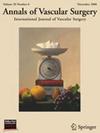Anatomical Study of Abdominal Wall Muscle Innervation to Optimize Retroperitoneal Vascular Approach
IF 1.4
4区 医学
Q3 PERIPHERAL VASCULAR DISEASE
引用次数: 0
Abstract
Introduction
Different surgical approaches are used in aortic surgery. Retroperitoneal approaches can result in abdominal wall weakness and flank bulging. These approaches often require dissection of the anterolateral or anteromedial muscles of the abdominal wall. During dissection, the underlying nerves are at great risk of injury, which induces significant complications in abdominal wall muscles. Few studies have been conducted to minimize the risk of injury to these nerves.
Objectives
This study aims to describe the trajectory of abdominal muscle motor nerves and their relationship to ribs and other anatomical landmarks. The secondary objective is to optimize surgical approaches by preserving the nerves.
Method
We conducted 12 dissections on fresh cadavers. Nerve trajectories, the communication between the intercostal nerves (9th–10th–11th) and the subcostal nerve (12th), and the distance from the nerve to the estimated projection point of intersection with the abdominal midline, umbilicus, and iliac crest were recorded.
Results
Our dissections identified the 12th subcostal nerve as the largest nerve. The 11th intercostal nerve exhibits more accessory branches than other nerves. Multiple communications and branches were observed between the 10th and 11th intercostal nerves and between the 11th and 12th nerves in the region from the anterior axillary line (AAL) to the mid-clavicular line. The estimated projection point of intersection with the midline was 7.92 ± 1.24 cm supraumbilical for the ninth intercostal nerve, 3.92 ± 1.18 cm supraumbilical for the 10th, 1.08 ± 1.52 cm at the umbilical level for the 11th, and −3.33 ± 0.83 cm infraumbilical for the subcostal nerve. The distance between the iliac crest and the iliohypogastric nerve (IHN) in the lateral jackknife position was 2.54 ± 0.65 cm. The 11th nerve had an angle in relation to the rib between −45° and −10° (average: −24.6°), and the 12th nerve had a similar angle between −30° and 0° (average: −18.3°). For the 11th nerve, the distance was between 0 and 5.5 cm (average: 2.92 cm); for the 12th nerve, it was between 0 and 3.0 cm (average: 1.71 cm).
Conclusions
To preserve the 11th nerve, the optimal approach is a straight incision starting from the upper edge of the 11th rib toward the midline, 4 cm above the umbilicus; for the 12th nerve, the optimal approach is a straight incision starting from the upper edge of the 12th rib toward the midline, 1 cm below the umbilicus; for the IHN, the optimal approach is an incision close to the iliac crest at a distance <1.5 cm. The estimated projection point of intersection between the nerve directions toward the midline can indicate the anatomical trajectory of nerves. A nerve projection toward the midline can provide valuable information about the anatomical location of a nerve. This study has utility in optimizing surgical approaches. A clinical study can confirm these anatomical results.
腹壁肌肉神经支配的解剖学研究,优化腹膜后血管入路。
导言:主动脉手术采用不同的手术方法。腹膜后入路可能导致腹壁薄弱和腹侧膨出。这些方法通常需要解剖腹壁的前外侧或前内侧肌肉。在解剖过程中,潜在的神经极有可能受到损伤,从而引起腹壁肌肉的严重并发症。目前很少有研究能最大限度地降低损伤这些神经的风险:本研究旨在描述腹肌运动神经的运动轨迹及其与肋骨和其他解剖标志物的关系。次要目的是通过保留神经来优化手术方法:方法:我们对新鲜尸体进行了 12 例解剖。方法:我们在新鲜尸体上进行了 12 例解剖,记录了神经轨迹、肋间神经(第 9-10-11 根)和肋下神经(第 12 根)之间的沟通情况,以及神经到与腹部中线、脐和髂嵴交汇的估计投影点的距离:结果:我们的解剖发现第 12 肋下神经是最大的神经。第 11 肋间神经比其他神经有更多的附属分支。在从腋前线到锁骨中线的区域内,第 10 和第 11 肋间神经之间以及第 11 和第 12 肋间神经之间有多处沟通和分支。第 9 肋间神经与中线交点的估计投影点在脐上 7.92 ± 1.24 厘米,第 10 肋间神经在脐上 3.92 ± 1.18 厘米,第 11 肋间神经在脐水平 1.08 ± 1.52 厘米,肋下神经在脐下 -3.33 ± 0.83 厘米。侧卧位时,髂嵴与髂腹股沟神经之间的距离为 2.54 ± 0.65 厘米。第11神经与肋骨的夹角在-45°和-10°之间(平均:-24.6°),第12神经与肋骨的夹角类似,在-30°和0°之间(平均:-18.3°)。第 11 神经的距离在 0 至 5.5 厘米之间(平均:2.92 厘米);第 12 神经的距离在 0 至 3.0 厘米之间(平均:1.71 厘米):保留第 11 根神经的最佳方法是从第 11 肋骨上缘向中线方向、脐上 4 厘米处开始的直线切口;保留第 12 根神经的最佳方法是从第 12 肋骨上缘向中线方向、脐下 1 厘米处开始的直线切口;保留髂腹股沟神经的最佳方法是靠近髂嵴的切口,距离为 0 至 5.5 厘米(平均:2.92 厘米);保留第 12 根神经的最佳方法是 0 至 3.0 厘米(平均:1.71 厘米)。
本文章由计算机程序翻译,如有差异,请以英文原文为准。
求助全文
约1分钟内获得全文
求助全文
来源期刊
CiteScore
3.00
自引率
13.30%
发文量
603
审稿时长
50 days
期刊介绍:
Annals of Vascular Surgery, published eight times a year, invites original manuscripts reporting clinical and experimental work in vascular surgery for peer review. Articles may be submitted for the following sections of the journal:
Clinical Research (reports of clinical series, new drug or medical device trials)
Basic Science Research (new investigations, experimental work)
Case Reports (reports on a limited series of patients)
General Reviews (scholarly review of the existing literature on a relevant topic)
Developments in Endovascular and Endoscopic Surgery
Selected Techniques (technical maneuvers)
Historical Notes (interesting vignettes from the early days of vascular surgery)
Editorials/Correspondence

 求助内容:
求助内容: 应助结果提醒方式:
应助结果提醒方式:


